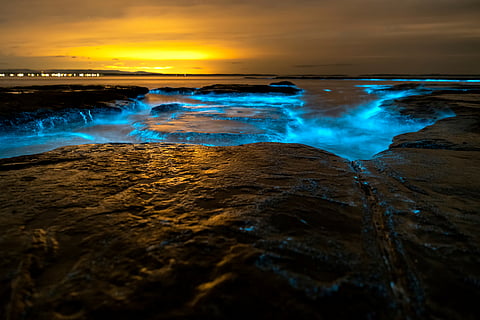
- Destinations
- Experiences
- Stay
- What's new
- Celebrating People
- Responsible Tourism
- CampaignsCampaigns
- SubscribeSubscribe
- Buy Now

India, known for its diverse landscapes and destinations, is also famous for a natural phenomenon that turns its coastal shores into magical realms after sunset. Bioluminescent beaches, where the waters sparkle with a mesmerising glow, are captivating locals and tourists alike. These bioluminescent beaches stand out as one of the most sought-after destinations for those seeking a unique and unforgettable experience.
Radhanagar Beach, located in the Havelock Islands of Andaman and Nicobar Islands, is known for its white sandy and pristine beaches and its bioluminescence plankton. These bioluminescence planktons create a blue glow, which is dreamy to watch. The best time to witness the spectacular view caused due to the planktons is during the monsoon season (June till September), at night, as during this time, the water is more likely to be disturbed due to the high tide. The best way to witness this beautiful phenomenon is by taking a boat ride at night. The boat will take you directly into the ocean, and due to disturbance in the flow of the waves, you can witness the glowing bioluminescence effect. The boat ride is also the safest way to witness the luminous effect and is also a great activity that the visitors like to engage in when visiting the Radhanagar beach.
Morjim, one of the most beautiful beaches of Goa, is also known for its nighttime scenic beauty caused due to bioluminescence planktons. The best time to visit the bioluminescence plankton is between June till September. Visitors can take a relaxing, calming walk along the shore of Morjim to witness the stunning bioluminescence effect. Bioluminescent planktons are harmless to humans therefore, swimming amidst the bioluminescent planktons is entirely safe. In addition to the bioluminescence planktons, the Morjim beach is also a nesting ground for Olive Ridley Sea turtles. If visiting in late September, you might be lucky to witness the sea turtles lay their eggs. Morjim Beach is a spectacular destination if you wish to see the bioluminescence of planktons, stunning sunsets, water sports, and delicious Goan cuisine.
The kind of spectacular beauty caused due to the bioluminescence of planktons at the Bangaram Islands is breathtaking. Situated amidst majestic palm trees and serene coasts, the Bangaram Islands is a less crowded island, providing you with a dreamy view of the planktons that will make you feel like you are part of a fantasy novel/film.
Bioluminescence is a natural phenomenon caused due to the chemical reactions that take place within an organism's body. When these organisms are even slightly agitated, they release a light-emitting pigment known as "Luciferase", which then interacts with oxygen and produces light. Bioluminescence depends on factors such as ocean water quality, weather, species, etc.
Due to a rapid increase in global warming levels, there has been a decline in the bioluminescence species. We as a society must do our bit by reducing our respective ecological footprint by avoiding the usage of single-use plastic when visiting bioluminescence areas, we can be responsible tourists and follow the given trails, avoid stepping on organisms, paths that will end up hampering the ecosystem.
